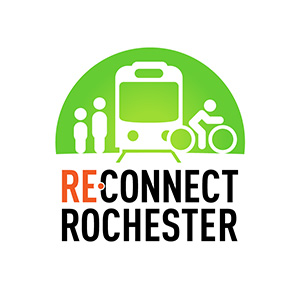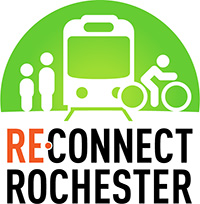The city of Rochester is now soliciting proposals for design of a new walking-biking trail on a bridge over the Genesee River near the University of Rochester.
The 1,600-foot-long stretch of trail would use the old Erie-Lackawanna Railroad bridge that crosses the river from the Plymouth-Exchange neighborhood to the university’s River Campus. It would connect with the excellent trails, much used by runners, walkers and riders, already in place on each side of the Genesee.
If I have the count right, the Erie-Lackawanna span would be the city’s seventh bridge over the river reserved for pedestrians and bikers – a most impressive number, in my view, for a city this size.

Footbridge near Brooks Avenue
How many have you sampled? There’s a spectacular high bridge (built atop a sewer pipe actually) at Seneca Park, a walkway atop a dam at the little-known Middle Falls, the Pont du Rennes at High Falls, the Sister Cities span downtown, the existing footbridge at the UR near Brooks Avenue, and a lovely little crossing at Genesee Valley Park south of Elmwood Avenue
Most if not all are connected by trails, I believe. A bike-rider could cross them all in what? An hour? Somebody try it and let me know. Send me pics.
Back to Footbridge 7 at the UR. If all goes well, the city will hold public meetings this fall, design will be done over the winter, construction will start next spring and the repurposed bridge will open in October 2011. The project will cost about $1.2 million, with the city and New York state splitting the tab.
According to this detailed
feasibility study done by Environmental Design and Research for the city and the Genesee Transportation Council two years ago, the bridge was built in the early 1900s, though earlier spans stood in that spot back to the 1850s. The rail line carried passenger and freight traffic between Rochester and Avon, Livingston County, with connections to points south. Erie-Lackawanna discontinued use of the line in 1971, a year before the rail company entered bankruptcy. The bridge has been unused since, except by occasional trespassers, and is now owned by the city.

The bridge as it is now (EDR feasibility study image)
When work is done, the bedraggled span will be transformed. It will have a new deck, be partly repainted, made ADA compliant and will sport ”amenities such as railing, lighting, benches, bike racks, and landscaping,” as the request for proposals put it.

The bridge as it may be (EDR feasibility study image)
Pretty nifty, eh? It should be a nice addition to the ever-growing network of trails in our region.
Oh, and if you’re not clear where these bridges are, here’s a home-made Google map, with the trails near the planned bridge marked as well. You’ll have to find the rest of the paths yourself. Enjoy!
Project Schedule
Start Work June 2010
Site Reconnaissance & Survey June 2010 – July 2010
Draft Alternatives Prepared July 2010 – August 2010
Host Citizen Advisory Meetings August 2010 – October 2010
Finalize Alternatives September 2010 – October 2010
Host Public Meeting(s) August 2010 – October 2010
Preliminary Design of Selected Alternative October 2010 – November 2010
Final Design & Construction Documents December 2010 – January 2011
Bid Process/Issuance of Construction Contracts February 2011 – April 2011
Construction Phase May 2011
Open Bridge October 2011







